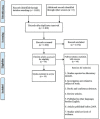Post-traumatic Trigeminal Neuropathy Associated With Endodontic Therapy: A Systematic Review
- PMID: 36686068
- PMCID: PMC9848699
- DOI: 10.7759/cureus.32675
Post-traumatic Trigeminal Neuropathy Associated With Endodontic Therapy: A Systematic Review
Abstract
A painful or non-painful trigeminal nerve lesion brought on by trauma that exhibits symptoms and/or clinical evidence of trigeminal nerve dysfunction is known as painful post-traumatic trigeminal neuropathy (PTTN). In relation to this, the term post-traumatic persistent dentoalveolar pain (PDAP) is an idiopathic condition of chronic neuropathic origin that manifests as a diagnostic challenge for dental practitioners. Neuropathic pain is defined by the International Association for the Study of Pain (IASP) as "pain initiated or caused by a primary lesion or dysfunction in the nervous system." PDAP is located primarily in the teeth and jaws. This study systematically reviews how likely it is to get painful PTTN if the patient received endodontic therapy and the duration between doing root canal therapy (RCT) and getting PTTN. A systematic review was carried out using key search terms from PubMed, Web of Science, and the Cochrane Central Register of Controlled Trials (CENTRAL) with English as the only permitted language. There were strict inclusion requirements. The 10 articles that were included showed a prevalence of an endodontic procedure anywhere from three to 48 months following post-endodontic treatment, and it mainly affects females in their mid-40s with no variation regarding the areas, whether it is in the maxilla or mandible. The lack of information about the association between RCT and PTTN led practitioners to make wrong diagnoses, which made the patient unwilling to seek further help. So, in this review, we identified some visible characteristics that can help in that process.
Keywords: atypical facial pain; atypical odontalgia (ao); neuropathic orofacial pain; persistent dentoalveolar pain (pdap); persistent idiopathic facial pain (pifp); phantom tooth pain; post-traumatic trigeminal neuropathy (pttn).
Copyright © 2022, Al-Khudhairy et al.
Conflict of interest statement
The authors have declared that no competing interests exist.
Figures
Similar articles
-
Molecular mechanisms of painful traumatic trigeminal neuropathy-Evidence from animal research and clinical correlates.J Oral Pathol Med. 2020 Jul;49(6):580-589. doi: 10.1111/jop.13078. Epub 2020 Jul 4. J Oral Pathol Med. 2020. PMID: 32557871 Review.
-
Neuropathic orofacial pain: Facts and fiction.Cephalalgia. 2017 Jun;37(7):670-679. doi: 10.1177/0333102417706310. Epub 2017 Apr 12. Cephalalgia. 2017. PMID: 28403646 Review.
-
Pulsed radiofrequency of superior cervical ganglion for treatment of painful post-traumatic trigeminal neuropathy (PTTN): A case series report.Cranio. 2022 Mar;40(2):166-173. doi: 10.1080/08869634.2019.1692284. Epub 2019 Nov 14. Cranio. 2022. PMID: 31726950
-
Persistent Dentoalveolar Pain Disorder: A Comprehensive Review.J Endod. 2018 Feb;44(2):206-211. doi: 10.1016/j.joen.2017.09.009. Epub 2017 Nov 23. J Endod. 2018. PMID: 29174443 Review.
-
Features of Neurovascular Orofacial Pain Compared to Painful Posttraumatic Trigeminal Neuropathy.J Oral Facial Pain Headache. 2020 Spring;34(2):121–128. doi: 10.11607/ofph.2448. Epub 2019 Sep 27. J Oral Facial Pain Headache. 2020. PMID: 31560735
Cited by
-
Are dentists aware of post-traumatic trigeminal neuropathic pain? A web-based epidemiological survey.J Oral Facial Pain Headache. 2025 Mar;39(1):103-111. doi: 10.22514/jofph.2025.009. Epub 2025 Mar 12. J Oral Facial Pain Headache. 2025. PMID: 40129427 Free PMC article.
References
-
- Persistent dentoalveolar pain disorder: a comprehensive review. Malacarne A, Spierings ELH, Lu C, Maloney GE. J Endod. 2018;44:206–211. - PubMed
-
- Atypical odontalgia: a non-odontogenic toothache of neuropathic origin. Ahlawat J, Malhotra A, Sharma A, Talwar S. Int J Res Ayurveda Pharm. 2016;7:98–101.
Publication types
LinkOut - more resources
Full Text Sources

